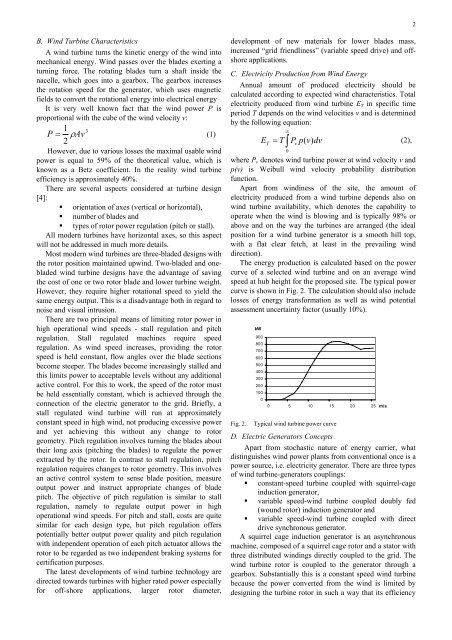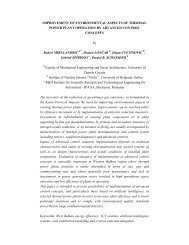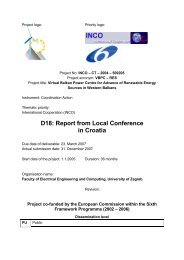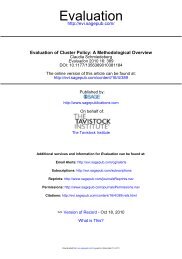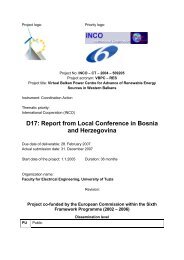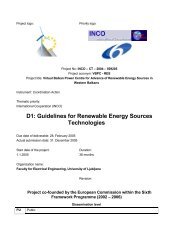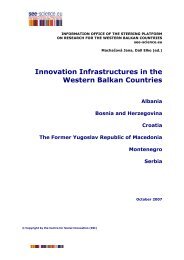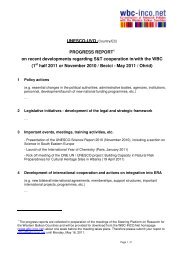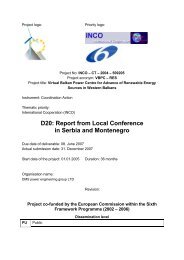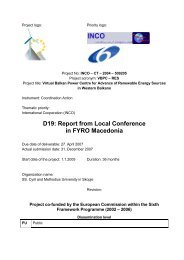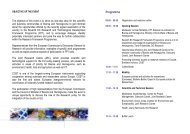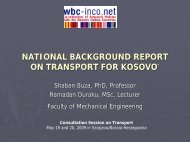Prva stran - WBC-INCO Net
Prva stran - WBC-INCO Net
Prva stran - WBC-INCO Net
You also want an ePaper? Increase the reach of your titles
YUMPU automatically turns print PDFs into web optimized ePapers that Google loves.
B. Wind Turbine Characteristics<br />
A wind turbine turns the kinetic energy of the wind into<br />
mechanical energy. Wind passes over the blades exerting a<br />
turning force. The rotating blades turn a shaft inside the<br />
nacelle, which goes into a gearbox. The gearbox increases<br />
the rotation speed for the generator, which uses magnetic<br />
fields to convert the rotational energy into electrical energy<br />
It is very well known fact that the wind power P is<br />
proportional with the cube of the wind velocity v:<br />
1 3<br />
P = ρAv<br />
(1)<br />
2<br />
However, due to various losses the maximal usable wind<br />
power is equal to 59% of the theoretical value, which is<br />
known as a Betz coefficient. In the reality wind turbine<br />
efficiency is approximately 40%.<br />
There are several aspects considered at turbine design<br />
[4]:<br />
orientation of axes (vertical or horizontal),<br />
number of blades and<br />
types of rotor power regulation (pitch or stall).<br />
All modern turbines have horizontal axes, so this aspect<br />
will not be addressed in much more details.<br />
Most modern wind turbines are three-bladed designs with<br />
the rotor position maintained upwind. Two-bladed and onebladed<br />
wind turbine designs have the advantage of saving<br />
the cost of one or two rotor blade and lower turbine weight.<br />
However, they require higher rotational speed to yield the<br />
same energy output. This is a disadvantage both in regard to<br />
noise and visual intrusion.<br />
There are two principal means of limiting rotor power in<br />
high operational wind speeds - stall regulation and pitch<br />
regulation. Stall regulated machines require speed<br />
regulation. As wind speed increases, providing the rotor<br />
speed is held constant, flow angles over the blade sections<br />
become steeper. The blades become increasingly stalled and<br />
this limits power to acceptable levels without any additional<br />
active control. For this to work, the speed of the rotor must<br />
be held essentially constant, which is achieved through the<br />
connection of the electric generator to the grid. Briefly, a<br />
stall regulated wind turbine will run at approximately<br />
constant speed in high wind, not producing excessive power<br />
and yet achieving this without any change to rotor<br />
geometry. Pitch regulation involves turning the blades about<br />
their long axis (pitching the blades) to regulate the power<br />
extracted by the rotor. In contrast to stall regulation, pitch<br />
regulation requires changes to rotor geometry. This involves<br />
an active control system to sense blade position, measure<br />
output power and instruct appropriate changes of blade<br />
pitch. The objective of pitch regulation is similar to stall<br />
regulation, namely to regulate output power in high<br />
operational wind speeds. For pitch and stall, costs are quite<br />
similar for each design type, but pitch regulation offers<br />
potentially better output power quality and pitch regulation<br />
with independent operation of each pitch actuator allows the<br />
rotor to be regarded as two independent braking systems for<br />
certification purposes.<br />
The latest developments of wind turbine technology are<br />
directed towards turbines with higher rated power especially<br />
for off-shore applications, larger rotor diameter,<br />
development of new materials for lower blades mass,<br />
increased “grid friendliness” (variable speed drive) and offshore<br />
applications.<br />
C. Electricity Production from Wind Energy<br />
Annual amount of produced electricity should be<br />
calculated according to expected wind characteristics. Total<br />
electricity produced from wind turbine ET in specific time<br />
period T depends on the wind velocities v and is determined<br />
by the following equation:<br />
∞<br />
E = T∫<br />
Pv<br />
0<br />
T p(<br />
v)<br />
dv<br />
(2),<br />
where Pv denotes wind turbine power at wind velocity v and<br />
p(v) is Weibull wind velocity probability distribution<br />
function.<br />
Apart from windiness of the site, the amount of<br />
electricity produced from a wind turbine depends also on<br />
wind turbine availability, which denotes the capability to<br />
operate when the wind is blowing and is typically 98% or<br />
above and on the way the turbines are arranged (the ideal<br />
position for a wind turbine generator is a smooth hill top,<br />
with a flat clear fetch, at least in the prevailing wind<br />
direction).<br />
The energy production is calculated based on the power<br />
curve of a selected wind turbine and on an average wind<br />
speed at hub height for the proposed site. The typical power<br />
curve is shown in Fig. 2. The calculation should also include<br />
losses of energy transformation as well as wind potential<br />
assessment uncertainty factor (usually 10%).<br />
kW<br />
900<br />
800<br />
700<br />
600<br />
500<br />
400<br />
300<br />
200<br />
100<br />
0<br />
0 5 10 15 20 25 m/s<br />
Fig. 2. Typical wind turbine power curve<br />
D. Electric Generators Concepts<br />
Apart from stochastic nature of energy carrier, what<br />
distinguishes wind power plants from conventional once is a<br />
power source, i.e. electricity generator. There are three types<br />
of wind turbine-generators couplings:<br />
constant-speed turbine coupled with squirrel-cage<br />
induction generator,<br />
variable speed-wind turbine coupled doubly fed<br />
(wound rotor) induction generator and<br />
variable speed-wind turbine coupled with direct<br />
drive synchronous generator.<br />
A squirrel cage induction generator is an asynchronous<br />
machine, composed of a squirrel cage rotor and a stator with<br />
three distributed windings directly coupled to the grid. The<br />
wind turbine rotor is coupled to the generator through a<br />
gearbox. Substantially this is a constant speed wind turbine<br />
because the power converted from the wind is limited by<br />
designing the turbine rotor in such a way that its efficiency<br />
2


